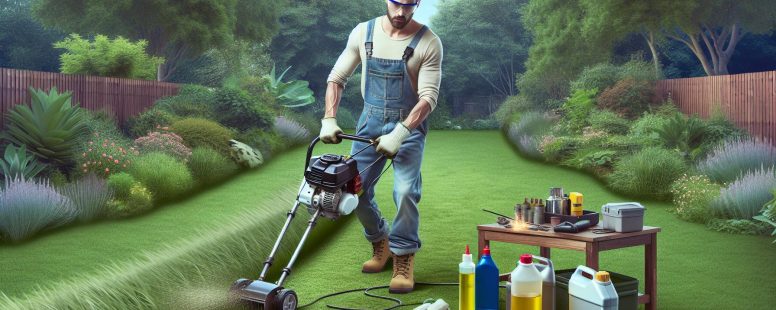Unveiling the Truth: Do Weed Eaters Need Oil for Optimal Performance?
Ever found yourself in the middle of a gardening spree, only to be halted by your trusty weed eater’s sudden performance dip? Could it be that you’re overlooking an essential maintenance step – oiling? You might’ve asked yourself: do weed eaters really need oil?
Weed eaters, or string trimmers as they’re often called, are vital tools for any green thumb. But like any machine with moving parts, there’s more than meets the eye when it comes to their care and upkeep. This article will jump into whether these handy garden helpers require oil and if so, how this small act can make a big difference in their longevity and effectiveness.
So buckle up! It’s time we unravel this common query once and for all – ensuring your beloved tool stays at its prime while keeping those pesky weeds at bay.
Understanding Weed Eaters
Diving deeper into the world of weed eaters, it’s crucial to get familiar with their various types and working mechanisms. This knowledge aids in understanding why some may need oil while others don’t.
Types of Weed Eaters
There are three primary types: electric, battery-powered, and gas-powered weed eaters.
- Electric models plug directly into an outlet using a cord for operation.
- Battery-Powered units rely on rechargeable batteries; these offer mobility without cords but might require frequent recharging depending upon usage patterns.
- Gas-Powered variants use gasoline as fuel; they’re potent tools often used by professionals due to their robustness and ability to tackle larger areas.
Each type has its own set of advantages that cater specifically towards individual gardening needs – be it residential or commercial use cases like parks or golf courses.
Working Mechanism of Weed Eaters
A basic understanding reveals how different weed eater designs have distinct operational methodologies:
- For electric & battery-operated versions – when you press the trigger, electricity flows through a motor causing rapid rotation which spins the cutting string at high speeds enough to cut grass blades effectively.
2.Inputting energy triggers spinning action in gas-powered devices too – but this time from combustion within engine cylinders rather than electrical power transfer via motors.
Do Weed Eaters Need Oil?
Before diving into the details, it’s essential to clarify that not all weed eaters require oil. The need for lubrication hinges on your specific model and its power source.
Why a Weed Eater Might Require Oil
Gas-powered weed eaters, unlike their electric or battery-operated counterparts, operate via internal combustion engines. These models resemble miniature car engines; hence they necessitate an adequate supply of oil for optimal functioning. Just as in vehicles, this fluid serves multiple roles:
- Lubricating Moving Parts: It minimizes friction among components such as pistons and cylinders.
- Cooling Engine Components: By circulating through hot areas of the engine,it helps dissipate heat effectively.
- Preventing Rust Formation: Coating metal parts with oil shields them from moisture so preventing rust formation.
In gas-fueled units specifically designed to run on mixtures of gasoline and two-cycle oils (also known as 2-stroke), you’ll blend these substances at specified ratios before fueling up your trimmer.
Consequences of Not Using Oil in Weed Eaters
Neglecting proper maintenance routines can have severe consequences if you own a gas-powered string trimmer requiring regular lubrification:
- Decreased Performance: Without appropriate levels of lubricant within the system,the equipment may struggle while cutting weeds due to increased resistance caused by lackluster movement between mechanical elements.
- Overheating Issues: Absence or insufficiency of cooling mechanisms could potentially cause overheats resulting even in spontaneous fires under extreme conditions!
3.Shortened Lifespan: Lacklustre care is likely linked with rapid wear-and-tear which might shorten lifespan significantly below what manufacturer claims .
To sum up,your decision whether to use oil or not should hinge entirely upon understanding type & operational mechanics underlying tool owned by yourself.Besides,diligent adherence to manufacturer-provided maintenance guidelines will ensure long-lasting performance from your weed eater.
Differentiating between Gas and Electric Weed Eaters
As you investigate deeper into the world of weed eaters, it’s crucial to understand their operational differences. Specifically, gas-powered models differ significantly from electric variants in terms of oil requirements.
Oil Requirements of Gas Weed Eaters
Gas weed eaters employ internal combustion engines for operation. These powerhouses aren’t just running on gasoline alone; they also require oil as an integral part of their fuel mixture—especially those designed for two-cycle operations.
The role that this lubricant plays is multi-faceted: It helps reduce friction among moving parts, keeps engine components cool during intensive use and prevents corrosion over time by creating a protective layer against rust formation.
But remember—it’s not just about pouring any type of oil into your machine. Each model has specific recommendations about the correct ratio mixtures with gasoline (usually denoted like 50:1 or 40:1), so make sure you’re following these guidelines closely from your manufacturer manual.
So yes! If you own a gas weed eater, then maintaining proper levels and quality types of oils are indeed non-negotiables for optimal functioning!
Oil Requirements Of Electric Weed Eaters
In contrast to their gas-guzzling counterparts, electric string trimmers operate differently—they function using motors powered by either direct electricity through cords or rechargeable batteries.
These kinds don’t need traditional engine oils since there are no combustive processes involved in generating energy needed for cutting tasks—that’s right – no cylinders revving up under intense heat conditions requiring cooling assistance!
But — while typical motor oils might be off the table here — keeping some essential parts clean & well-lubricated can still ensure smooth performance & longer lifespan- elements such as spools spinning out strings rapidly which may get worn down due to continuous rubbing against each other would appreciate occasional greasing sessions.
Proper Maintenance of Weed Eaters
Maintaining your weed eater ensures it stays in optimal condition, offering smooth operation and long-lasting performance. This section details the regular cleaning process and proper storage methods that play a significant role in maintaining these garden tools.
Regular Cleaning and Inspection
Routine inspection is paramount for identifying any potential issues before they escalate into bigger problems. Start by checking the cutting head after every use to ensure there are no entangled weeds or grass clippings hindering its movement. A quick rinse under running water often suffices for most models, especially those powered electrically or by batteries.
For gas-powered units with combustion engines, inspect spark plugs periodically as deposits can build up over time affecting their efficiency. Replace them if corroded or damaged beyond simple cleaning measures.
Remember to check air filters too; clean ones optimize engine performance while clogged ones restrict airflow leading to decreased power output and increased fuel consumption in case of gas variants. It’s wise also to verify string line conditions frequently – worn-out lines diminish cutting effectiveness significantly which calls for prompt replacement.
Ensure you lubricate all moving parts regularly using manufacturer-recommended oil types (if applicable).
Finally but importantly is examining shafts: Cracked/broken pieces pose safety hazards hence immediate replacements become necessary once identified.
Proper Storage Methods
How you store your weed eater when not actively tending gardens matters considerably towards extending its lifespan.
Firstly, always remember to cool down equipment post usage prior storing away safely- residual heat from operations could potentially warp plastic components compromising structural integrity eventually resulting shortened lifespans eventually even failure altogether at worst-case scenarios!
Secondly avoid leaving machines out exposed weather elements like sun rain snow etcetera protect against rusting fading other forms degradation due exposure extreme environmental conditions ideally keep tool indoors dry ventilated area alternatively covers serve purpose excellently well ensuring shielded damaging influences nature meanwhile moisture prevention becomes crucial deter formation mildew mold which potentially ruin device’s internal workings.
Also, remember to empty the fuel tank of gas-powered models before long-term storage. Remaining gasoline could degrade over time leading to gummy deposits that block engine parts hampering their smooth operation when you next decide it’s weed management time!
Finally for corded electric or battery-operated variants make sure retract cords properly avoid tangling knots causing damage meanwhile batteries stored room temperature locations protect against extreme cold heat variations detrimental overall health life span charge holding capacities eventually ensuring ready power supply whenever need arises managing weeds garden becomes child play well-maintained equipment hands!
Tips for Choosing the Right Oil for Your Weed Eater
Selecting the right oil is vital to keep your weed eater functioning optimally. It’s about understanding different oil grades and selecting high-quality oils, which align with your equipment’s requirements.
Understanding Oil Grades
Oil grades matter significantly when it comes to lubricating machines like gas-powered weed eaters. You’ll notice these are usually indicated as ‘2-cycle engine oils’ or ‘4-cycle engine oils.’ For instance, a 2-stroke (or cycle) machine mixes fuel and oil in a particular ratio before burning it off completely during operation; hence you’d require specially designed two-stroke motor oil here.
These ratings denote viscosity levels – essentially how thick or thin an oil can be at specific temperatures. The Society of Automotive Engineers (SAE) classifies them into winter (‘W’) and summer categories that indicate their performance under cold conditions and heated operations respectively.
Let’s consider SAE 30 versus SAE 10W-40: while both could have similar viscosities at operating temperature, they behave differently when starting up in colder weather due to differing ‘Winter’ viscosities. Remember this information next time you’re shopping around!
Selecting High-Quality Oils
You’re spoilt for choice with so many brands out there claiming superiority over others! Here’s some guidance on exploring through those claims:
- Manufacturer Recommendation: Always follow what’s recommended by your equipment manufacturer – typically found within user manuals.
- API Service Classification: Lookout for API service classifications such as TC-W3® indicating Two-Cycle engines using Water-cooled systems—typically suitable across various manufacturers.
3.Smokeless Formulations**:** These reduce smoke emissions—an important factor considering environmental concerns nowadays!
4.Anti-scuff/Anti-wear Additives**:** Certain additives provide extra protection against wear-tear, enhancing your equipment’s life.
- Biodegradability: Consider oils that are biodegradable and eco-friendly if you’re environmentally conscious.
Conclusion
You’ve now got the knowledge you need to properly maintain your weed eater, regardless of its power source. Remember, it’s all about understanding your specific model and how it works. Gas-powered units require oil for efficient functioning – don’t forget that right mix! Electric or battery-operated models? No traditional engine oils needed but do keep those spools lubricated for optimal performance.
Maintenance isn’t just a one-time deal either; regular cleaning checks are vital too – inspecting cutting heads after each use, checking spark plugs and air filters in gas models, ensuring string lines stay strong. And let’s not neglect storage practices: cool down before storing away from weather elements with empty fuel tanks on gas variants.
Choosing high-quality oil is crucial if you own a gas weed eater – consider viscosity levels based on temperature variations and look out for API classifications as well as smokeless biodegradable options to promote environmental sustainability. Follow these tips closely while adhering to manufacturer guidelines so that you can enjoy an effective gardening experience without having any trouble managing weeds around your property.




